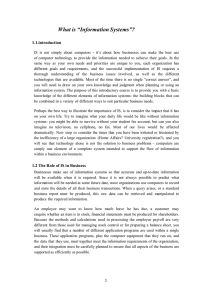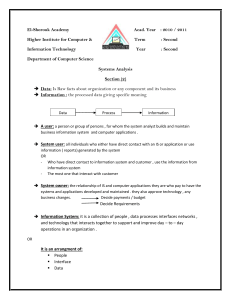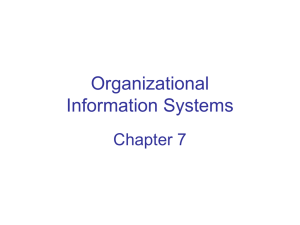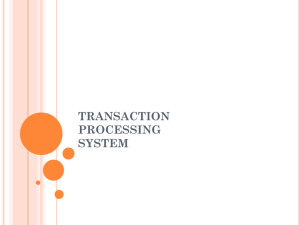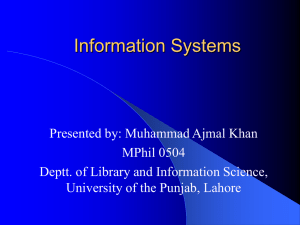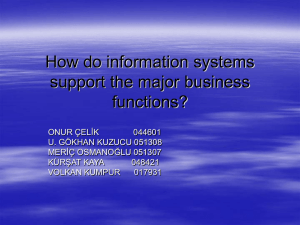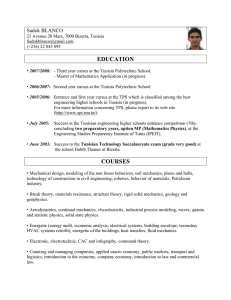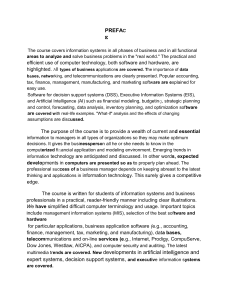Information System:
advertisement
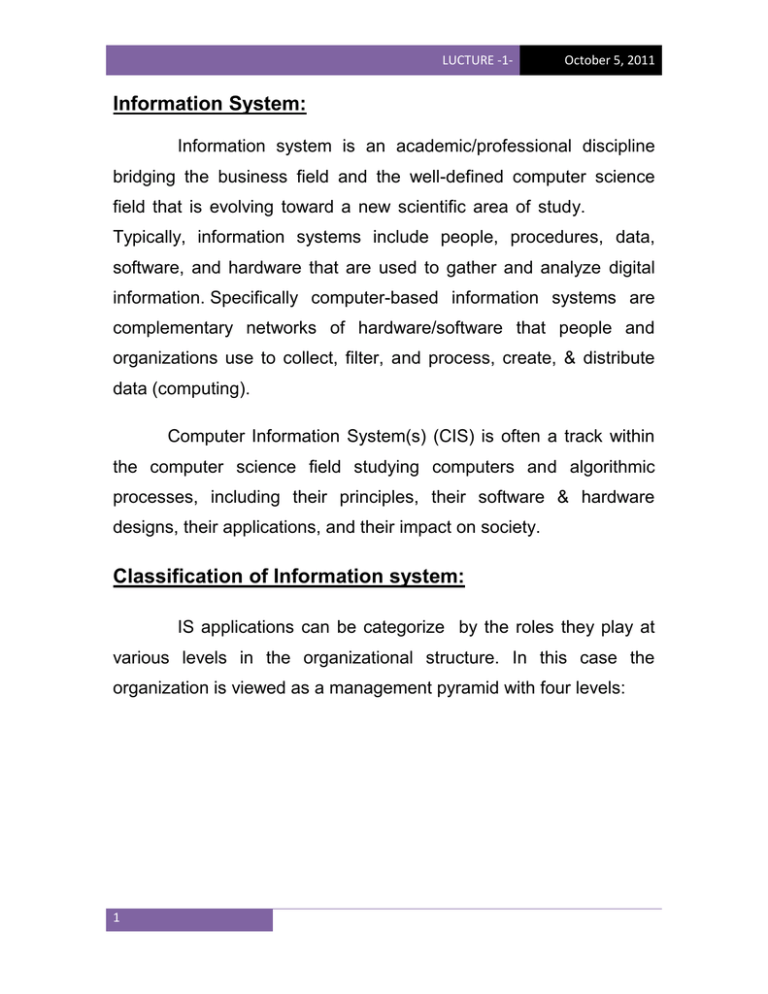
LUCTURE -1- October 5, 2011 Information System: Information system is an academic/professional discipline bridging the business field and the well-defined computer science field that is evolving toward a new scientific area of study. Typically, information systems include people, procedures, data, software, and hardware that are used to gather and analyze digital information. Specifically computer-based information systems are complementary networks of hardware/software that people and organizations use to collect, filter, and process, create, & distribute data (computing). Computer Information System(s) (CIS) is often a track within the computer science field studying computers and algorithmic processes, including their principles, their software & hardware designs, their applications, and their impact on society. Classification of Information system: IS applications can be categorize by the roles they play at various levels in the organizational structure. In this case the organization is viewed as a management pyramid with four levels: 1 LUCTURE -1- October 5, 2011 Transaction Processing Systems At the lowest level of the organizational hierarchy we find the transaction processing systems (TPS) that support the day-to-day activities of the business. These applications are normally the first to be computerized and are characterized by large numbers of transactions updating the database. For example, the itemized till slip from a supermarket is produced by the TPS, and details of each individual item sold will be recorded in the store’s database. Management Information Systems This level contains computer systems that are intended to assist operational management in monitoring and controlling the transaction processing activities that occur at clerical level. Management information systems (MIS) use the data collected by the TPS to provide supervisors with the necessary control reports. The 2 LUCTURE -1- October 5, 2011 main focus of MIS is to avoid wading through huge volumes of detailed data, instead using control totals to identify problems. Decision Support Systems Tactical management occupies the next level in the organizational hierarchy. These managers are responsible for ensuring that plans and targets set by senior management are achieved. Many organizations have recognized the importance of this type of information need, and have implemented sophisticated user driven decision support systems (DSS) which allow managers to generate their own reports and enquiries. When information is required to support management decision making, the user is able to interact directly with the computer via a graphical user interface to request the relevant data, select and apply the appropriate decision model and generate the output report in the format required. Executive Information Systems The highest level in the organizational structure is that of strategic management. These managers are charged with the task of setting the strategy for the organization. They require an information system that will enable them to identify problems. If a problem is identified by top management, then the EIS provides the facility to drill down to a lower level of detail in the database to obtain a better understanding of the problem and its causes. Office Automation Systems (OAS) 3 LUCTURE -1- October 5, 2011 Other types of information systems are not specific to any one level in the organisation but provide important support for a broad range of users. Many standard computer applications, such as word processing, spreadsheeting, data management, and presentation graphics are used across all management levels of the organisation. Word processing software is used to create and maintain electronic documents. Because word processors create virtual (electronic) documents as opposed to physical ones, any errors or alterations can be made to the document before it is printed. however, as personal computers and word processing packages become more powerful, so users need to update their skills so they can use the next generation of software. Spreadsheets They allow for easy preparation of financial statements, cash flows, budgets and other problems requiring quantitative analysis. Today’s spreadsheet packages also offer a variety of statistical and business analysis tools, together with the abilityto generate business charts directly from the spreadsheet data. Data management software is used to create and maintain records about items such as customers, employees, which are vital to the operation of any business. 4 LUCTURE -1- October 5, 2011 The main advantage of automation is the power of the computer to select, sequence, summarise and report on data once it has been captured. In addition, data management software incorporates error-checking features. Presentation graphics software provides an easy means of generating high quality presentation materials based on colour overheads, slides or large screen displays. The latest versions include advanced slide show facilities together with animation and sound clips. This has become a popular tool for marketing, executive reporting, training and seminars. Groupware: Groupware is the term given to software developed to support the collaborative activities of work groups, with typical requirements being information sharing, electronic meetings, scheduling and email. Groups are often informal and could include members of a project team, employees within a department, or individuals with a common interest. Project management Software provides graphical tools to help manage projects by sequencing tasks, allocating and scheduling resources and reporting on project progress. 5 LUCTURE -1- October 5, 2011 Electronic meeting Software is designed to support interaction between members of a distributed group, without the cost and time wasted through travelling to a physical destination. Here groups can log into an electronic meeting from their offices or in special purpose electronic meeting rooms. Electronic mail , Commonly referred to as e-mail, can be defined as the electronic exchange of messages between users. Where a user has the required software and links to the internet. The message is then transferred across the network and stored on the network server in the recipient’s mailbox from where it can be retrieved. Files can be attached to e-mail transmissions, so any material in electronic form can be communicated across the internet. 6
